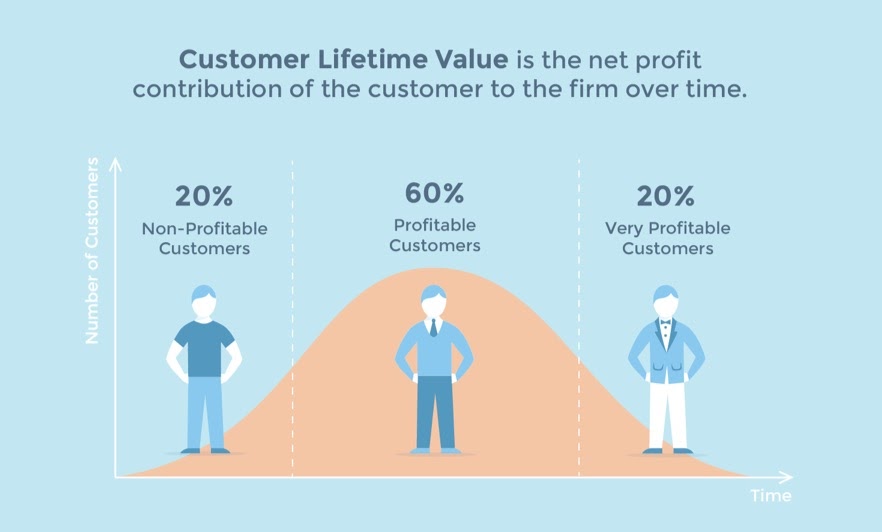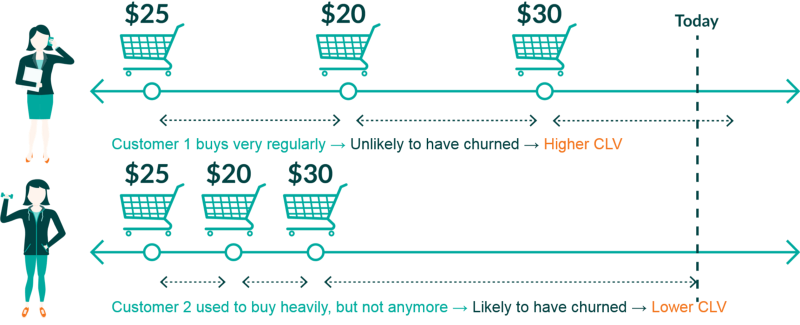What is Customer Lifetime Value? Discover How to Boost Your ROI
In the digital marketing space, no matter how much of a strategy we implement in our company, if we neglect to analyze what works and what doesn’t bring us anything, we won’t get the maximum ROI we desire. We can apply this principle to multiple contexts within the digital business, including to customers. We call this indicator the Customer Lifetime Value.
Customer Lifetime Value (CLV, or CLTV) is a metric companies use to determine the value or profit a customer brings them during a set amount of time. It’s a marketing principle that’s critical for us to get to know our customers and their behaviour to figure out the value they bring to our business and create a 360° marketing strategy tailored to their needs.
Defining customer lifetime value helps us answer the following questions:
- Are the customers we’re acquiring profitable in the long-term?
- Are we investing enough resources in making customers loyal and satisfying them according to their CLV?
- What future strategies do we have to improve their loyalty to our brand?

(Image: Pinterest)
Why is Customer Lifetime Value important to marketers?
We know that it’s five times harder to acquire a new customer than to make a previous customer make a repeat purchase. That’s why customer retention tends to be a more cost-effective strategy than acquisition. The customer life cycle helps us calculate the monetary value that each of these cases brings to our bottom line. The end-goal is clear: carry out consistently profitable actions for your brand. We’ll need to understand our customer journey map well. The customer journey is the path that people through each stage of the purchasing cycle and their experiences in each phase.
The Customer Lifetime Value calculation is vital for marketing departments to deploy the appropriate resources for this commercial relationship that has a close bond to loyalty. An example of this is if we have a customer who’s bought the same coffee brand, that customer is more profitable and makes a greater contribution to our margin and sales. In other words, they’re worth more to us. Therefore, it’s more critical to retain that customer and focus on maintaining them than occasionally buying from us because of the higher purchase frequency.
A study from Arya Systems found that 75% of North American senior executives say that CLV is an extremely valuable metric for their organizations. Another report from Avaya concluded that those firms that already rely on the Customer Lifetime Value in their digital strategies view it as a handy measure to:
- Justify new technology investment and purchasing decisions.
- Measure profitability.
- Monitor cost-reduction initiatives.
- Compare different customer segments.
How do you measure customer lifetime value? You can’t calculate it without the appropriate insights. So, what are those measures to help support your CLV calculations? You have to base your customer lifetime value model on precise data from every customer, flexible technology, and determine what benefits are part of how your organization is going to calculate a customer lifetime value. Another useful, practical tool is the Buyer Persona, which lets us have our ideal customer in mind and see if it correlates with our current customer and life cycle.
How to calculate Customer Lifetime Value
Like all our other KPIs, we must define the parameters that help us determine the time and budget we’ll allocate to every customer.
 (Image: Pinterest)
(Image: Pinterest)
ACUCM (Administering Cisco Unified Communications Manager) says that some of the values we should take into consideration are:
- The monetary amount of their purchases.
- The percentage of customers that give you feedback.
- The rate of customers that talk about you and publicize your brand.
- Percent of customers that follow through with their “purchases.”
- The size of their social media presence (number of contacts, followers, social media activity, and more).
In any case, these values gather what the customer could end up spending, the spend we must make to attract a new customer to our brand, or make an already-existing customer loyal to us, etc. You then plug in all of these values into a formula and get the average. If you’re curious about how the math works, take a look at this video to walk you through all the steps to calculate the total revenue customers contribute to your CLV:
Imagine we have a hotel where we have an occasional guest that comes every summer and during the holiday season with their family or friends, depending on the occasion. Along with booking a room, the guest reserves many meals in the hotel gets spa services and uses our concierge to book tickets to museums or entertainment events.
On the other hand, we have another guest who comes every few years, stays at the hotel, and never uses any of our other amenities. Plus, their only comment on their TripAdvisor review is relatively neutral or veering towards negative. Looking at both of these customers, each of these guests’ CLV is radically different for us. We’ll then want to send and serve them personalized advertising with content that best suits their behaviour towards us, and as a result, the actions we’ll implement will have a different look and feel. This approach ensures the campaigns we build offer these customers the message they’re looking for, so we sell them the appropriate product in the right place at the right time. This analysis will help us invest in a more optimized process for our marketing.
Defining your organization’s Customer Lifetime Value lets you get the most out of every touchpoint your customer has with your brand while offering them better service while fostering loyalty through consistent, profitable actions for your organizations. Pursuing a path of measuring customer lifetime establishes a way for those customers that occasionally goes to the products or services from another firm can come back to us.
Subscribe to our newsletter and stay up to date with the latest digital trends.
Subscribe to our newsletter and stay up to date with the latest digital trends.
No thanks. My inbox is fine as it is.